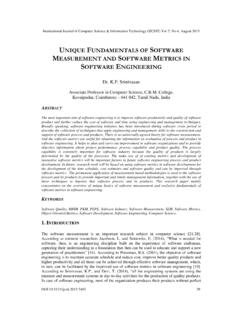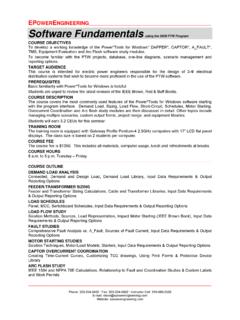Transcription of Fundamentals of Systems Engineering - MIT …
1 Fundamentals of Systems Engineering Prof. Olivier L. de Weck Session 11 Lifecycle Management 1 General Status Update 23 Outline for Today Definition of Lifecycle Management Lifecycle Properties, the Illities A Case Study Reconfiguration of Communications Satellite Constellations Summary of Key Concepts taught in this class Career / Study Recommendations regarding SE 4 Lifecycle Management Lifecycle Management is the active engagement of all stakeholders with a system between the time when it first starts to operate until the time of its decommissioning, in order to maximize the value gained from the system s existence. Lifecycle management starts from the beginning. Lifecycle Management can include activities such as: Daily Operations and Monitoring Training and Certification of Operators Servicing, incl. Preventative and Corrective Maintenance Dealing with small and large failures, recalls, anomalies Protecting the system from random or targeted attacks (cyber-physical) Sharing and archiving the data produced by the system Upgrading and retrofitting the system as needed Cross-strapping the system with other Systems in a federation of Systems Reducing the resource consumption and environmental burden Decommissioning the system when it is time to do so 5 system Engineering Lifecycle (Part 1/2) Conception, Design, Implementation 1 Beginning of Lifecycle - Mission - Requirements - Constraints Customer Stakeholder User Architect Designer system Engineer Conceive Design Implement process information turn information to matter SRR PDR CDR iterate iterate The Environment.
2 Technological, economic, political, social, nature The Enterprise The system creativity architecting trade studies modeling simulation experiments design techniques optimization (MDO) virtual real Manufacturing assembly integration choose create 6 Systems Engineering Lifecycle (Part 2/2) Operate, Upgrade, Liquidate 1 The system real AR virtual Customer Stakeholder User EOL test deploy service monitor Operate Upgrade Liquidate degrade Architect Designer system Engineer accept control usage testing validation verification The Enterprise monitor control usage The Environment: technological, economic, political, social, nature system ID behavior prediction End of Lifecycle 7 Space Shuttle Lifecycle (1971-2011) Vision: partially reusable space vehicle with quick turnaround and high flight rate Actual: complex and fragile vehicle with average cost of about $ (20,000 workforce) Why? Overoptimism Congress capped RDT&E at $ (1971) Focus on achieving launch performance (24 mt LEO) Maintainability needed to be designed-in No realistic lifecycle cost/value optimization done Olivier de Weck, April 2011 Page 8 C D I O system architecture design testing manufacturing operations What we wanted What we got IOC Roger Pielke Jr & Radford Byerly, Shuttle programme lifetime cost, Nature 472, 38 (07 April 2011) $192B Total, 135 launches Challenger Columbia Reprinted by permission from Macmillan Publishers Ltd: Nature.
3 Source: Figure of A Costly Enterprise" in Pielke Jr, Roger, and Radford Byerly, "Shuttle programmelifetime cost." Nature 472, 38. image is in the public image is in the public 15288 Most important standard for lifecycle ISO/IEC IEEE 2008. All rights content isexcluded from our Creative Commons license. For moreinformation, see for Today Definition of Lifecycle Management Lifecycle Properties, the Illities A Case Study Reconfiguration of Communications Satellite Constellations Summary of Key Concepts taught in this class Career / Study Recommendations regarding SE 10 Reference Paper de Weck , Ross A., Rhodes D., Investigating Relationships and Semantic Sets amongst system Lifecycle Properties (Ilities) , 3rd International Engineering Systems Symposium, CESUN 2012, TU Delft, The Netherlands, June 18-20, 2012 11 What are the Illities ? Complex Engineering Systems live for decades or centuries The ilities are desired properties of Systems , such as flexibility or maintainability (usually but not always ending in ility ) that often manifest themselves after a system has been put to initial use.
4 These properties are not the primary functional requirements of a system s performance, but typically concern wider system impacts with respect to time and stakeholders than embodied in those primary functional requirements Most research has looked at the Illities one at a time. Research Questions: What are the most prevalent or most important (top 20) Ilities in the scientific literature and in common use? What are the relationships amongst Ilities? Do they form semantic sets? Can we use this information for better system design? Approach: Method 1: Prevalence Analysis using Literature/Web Survey Method 2: Human Cognitive Experiments using Hierarchy Exercise 12 Prevalence Analysis Internet Scientific Articles common usage is leading academic interest is leading Journal Articles from Compendex/Inspec Databases between 1884 and 2010 13 Cumulative Research in Ilities over Time Olivier de Weck, April 2011 Page 14 Cumulative number of journal articles where an Ility appears in the title orabstract of the paper (1884-2010).
5 Source: Inspec and Compendex,accessed via Engineering Village Fig. 4-2 141: Relationships amongst the Ilities Olivier de Weck, June 2012 Page 15 Source: web keyword 2-tupel correlation analysis, August 2010 Network structure with classical Engineering ilities at the core and newer emerging ones at the periphery based on co-occurrence Line weight reflects strength of relationships Cutoff value for edge strength is Made well with high quality in early life Easy to change system configuration Performs well over time under uncertainty 152: Human Experiments with Hierarchy Humans have deep, but possibly varied, semantic notions of a hierarchy of Ilities Elicit means-ends-hierarchy through direct elicitation and group discussion and interviews Two rounds Round 1: 4 groups with 2-4 members each. Find parent-child relationships. Describe means ends relations Interviews Round 2: Revise group findings based on inputs from other groups at the end of round 1 Constructed combined means-ends hierarchy Ility Name Definition ( ability of a ) adaptability to be changed by a system -internal change agent with intent agility to change in a timely fashion changeability to alter its operations or form, and consequently possibly its function, at an acceptable level of resources evolvability design to be inherited and changed across generations (over time) extensibility to accommodate new features after design flexibility to be changed by a system -external change agent with intent interoperability to effectively interact with other Systems modifiability to change the current set of specified system parameters modularity degree to which a system is composed of modules (not an ability-type ility)
6 Reconfigurability to change its component arrangement and links reversibly robustness to maintain its level and/or set of specified parameters in the context of changing system external and internal forces scalability to change the current level of a specified system parameter survivability to minimize the impact of a finite duration disturbance on value delivery value robustness to maintain value delivery in spite of changes in needs or context versatility to satisfy diverse needs for the system without having to change form (measure of latent value) 12 experienced system designers and researchers were presented with a list of 15 ilities like this one What is their relationship? Do they form a hierarchy? 16 Group 1 Group 2 Group 3 Group 4 17 Combined Means to Ends Hierarchy 18 Summary of Lifecycle Properties Lifecycle properties (Ilities) are critical for long term value Despite differences, the two methods led to similar high-level conclusions regarding the relationships amongst Ilities: Some ilities are closely related to each other and form semantic sets that are tied together by both synonymy and polysemy relationships.
7 system value is heavily driven by the ability of a system to be robust (despite internal and exogenous disturbances), flexible or changeable and resilient or survivable over time. A hierarchy of ilities with two or three levels appears to exist whereby some ilities, such as modularity and interoperability appear at lower levels and serve as enablers of higher level ilities. Future work will apply both methods to larger sets of ilities, with larger groups of test subjects and will use consistent sets of ilities 19 Outline for Today Definition of Lifecycle Management Lifecycle Properties, the Illities A Case Study Reconfiguration of Communications Satellite Constellations Summary of Key Concepts taught in this class Career / Study Recommendations regarding SE 20 Communications Satellite Constellation Case Iridium and Globalstar Integrated Lifecycle Modeling Flexibility / Scalability: Staged Deployment Approach de Weck, , de Neufville R.
8 And Chaize M., Staged Deployment of Communications Satellite Constellations in Low Earth Orbit , Journal of Aerospace Computing, Information, and Communication, 1 (3), 119-136, March 2004 21 Existing Big LEO Systems Iridium Globalstar Time of Launch 1997 1998 1998 1999 Number of Sats. 66 48 Constellation Formation polar Walker Altitude (km) 780 1414 Sat. Mass (kg) 689 450 Transmitter Power (W) 400 380 Multiple Access Scheme Multi-frequency Time Division Multiple Access Multi-frequency Code Division Multiple Access Single Satellite Capacity Global Capacity Cs 1,100 duplex channels 72,600 channels 2,500 duplex channels 120,000 channels Type of Service voice and data voice and data Average Data Rate per Channel kbps kbps Total system Cost $ billion $ billion Current Status Bankrupt but in operation. IridumNEXT under development (2017) Bankrupt but in operation. Globalstar now publicly traded and valued at $ Individual Iridium Satellite Individual Globalstar Satellite 22 Motivation: Iridium Satellite system Difficult to properly size capacity of large system Market assumptions can change when 7-8 years elapse between conceptual design and fielding (1991-1998) 'Motorola unveils new concept for global personal communications: base is constellation of low-orbit cellular satellites', Motorola Press Release on Iridium, London, 26 June 1990.
9 Last week, Iridium LLC filed for bankruptcy-court protection. Lost investments are estimated at $5 billion. Wall Street Journal, New York, 18 August 1999. Iridium Satellite 0204060801001201991 1992 1993 1994 1995 1996 1997 1998 1999 2000 YearMillions of subscribersUS (forecast)US (actual)23 Satellite system Economics ,1,11100365 24 60 TTops iiTsf iikICCPFCL Lifecycle cost Number of billable minutes Cost per function [$/min] Initial investment cost [$] Yearly interest rate [%] Yearly operations cost [$/y] Global instant capacity [#ch] Average load factor [ ] Number of subscribers Average user activity [min/y] Operational system life [y] 365 24 IkopsCsCfLuNuA1,200 [min/y]uA TNumerical Example: [$/min]CPF 3 [B$]I 5 [%]k 300 [M$/y]opsC 100,000 [#ch]sC 63 10uN 15 [y]T But with Nu=50, [$/min]CPF Non-competitive 24 Design (Input) Vector X Constellation Type: C Orbital Altitude: h Minimum Elevation Angle: emin Satellite Transmit Power: Pt Antenna Size: Da Multiple Access Scheme MA: Network Architecture.
10 ISL Design Space Polar, Walker 500,1000,1500,2000 [km] , , [deg] 200,400,800,1600,2400 [W] , , [m] MF-TDMA, MF-CDMA [-] yes, no [-] This results in a 1440 full factorial, combinatorial co design space Astro- dynamics Satellite Design C: 'walker' h: 2000 emin: Pt: 2400 DA: 3 MA: 'MFCD' ISL: 0 X1440= Network 25 Objective Vector (Output) J Performance (fixed) Data Rate per Channel: R= [kbps] Bit-Error Rate: pb=10-3 Link Fading Margin: 16 [dB] Capacity Cs: Number of simultaneous duplex channels Cost Lifecycle cost of the system (LCC [$]), includes: Research, Development, Test and Evaluation (RDT&E) Satellite Construction and Test Launch and Orbital Insertion Operations and Replenishment Page 26 26 Multidisciplinary Simulator Structure Constellation Satellite Network Link Budget Spacecraft Cost Launch Module Capacity Input Vector Constants Vector Output Vector x p J satmNote: Only partial input-output relationships shown min,h ,TpnGWspotnsRsCLCC,,taP D MAISL satmLVsatmSatellite Mass TNumber of Satellites pNumber of orbital planes spotnNumber of spot beams nGWNumber of gateways LVLaunch vehicle selection 27 Governing Equations Satellite Simulator a) Physics-Based Models br t0space add.



















